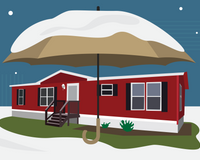Structural Variations
The landscape of modern housing is ever-evolving, with innovative designs that cater to diverse lifestyles. Mobile and tiny housing styles are among these trends, with each offering unique benefits and challenges.Mobile Home Layout
Mobile homes (also known as modular or manufactured homes) are a revolution in housing flexibility. Constructed on a steel chassis with wheels, these homes are designed to be movable, providing homeowners with the unique ability to relocate their living space. This is an advantage for those who desire the freedom to move — all without the burden of purchasing a new property or dealing with the complexities of traditional home sales.In terms of size, mobile homes generally offer more square footage than their tiny counterparts. This additional space allows for a more conventional home layout, often including multiple bedrooms, a full-sized kitchen, and ample living areas. However, the larger size does not compromise the quality of construction, as mobile homes adhere to specific building codes and standards (i.e. HUD Code). This ensures they are built to be durable and safe for transport.
Tiny Home Layout
On the flip side, tiny homes have carved out a niche for those seeking a minimalist lifestyle or a smaller ecological footprint. Unlike mobile homes, tiny homes are usually constructed on a permanent foundation. The essence of tiny living is the ingenious use of space, where every square inch is carefully considered to maximize functionality.Tiny homes are typically much smaller than mobile homes, which often results in lower utility costs and maintenance. Despite their diminutive size, these homes are not short on style; many tiny homes feature unique architectural designs, blending aesthetics with practicality. From fold-out furniture to lofted sleeping areas, tiny homes are a testament to the creativity of modern living.
Regulatory Framework
Besides having an understanding of the mobile home vs. tiny home structure, the regulatory framework is just as vital for ensuring compliance. Both homes fall under different sets of regulations that can significantly impact their construction, habitation, and mobility.Mobile Homes: Guided by HUD Standards
Mobile homes are regulated by the HUD (U.S. Department of Housing and Urban Development) Code. This federal code preempts local and state building codes while setting national standards for their construction, design, and performance.The HUD Code covers a wide range of safety standards. These include laws for fire protection, structural integrity, energy efficiency, and transportation. As a result, mobile homes are not only safe for residents but also structurally sound for travel on public roadways.
All manufactured homes must have a HUD label, which certifies that the home has been inspected and meets the appropriate standards.
Tiny Homes: A Patchwork of Regulations
Tiny homes face a more complex standard. The classification of a tiny home can vary, which in turn affects the regulations to which it is subject. Some tiny homes are built on foundations and are intended to serve as permanent residences. These homes typically need to comply with local building codes, which can be challenging given their small size and unconventional layouts.Alternatively, tiny homes built on trailers may be classified as RVs, which means they must adhere to standards set by organizations like the RV Industry Association. These standards are less stringent than residential building codes and focus on the home's safety while it is in transit.
In some cases, tiny homes can be built under alternative building codes, such as the International Residential Code (IRC) for small houses. This provides guidelines for homes smaller than traditional houses but larger than typical tiny homes on wheels.
Mobility and Portability
In a world where the concept of home is no longer tied to a fixed location, the appeal of mobile and tiny homes has surged. These alternative living spaces offer varying degrees of mobility, providing a sense of freedom that traditional homes simply cannot match.Mobile Homes: Relocation with Ease
True to their name, mobile homes are designed with movement in mind. These homes are built on a chassis with wheels, allowing them to be hitched to a vehicle and transported to a new location. This feature particularly appeals to homeowners who anticipate future relocations or wish to explore different living environments.The ability to move one's home can be a significant advantage for those with jobs that require frequent relocation, as well as individuals who simply enjoy the freedom of change. The design of mobile homes takes transportation into account, ensuring that they can withstand the rigors of travel and be set up with relative ease at a new destination.
Tiny Homes: Portability with a Purpose
Tiny homes offer a different take on portability. While many are built on permanent foundations, a segment of the tiny home community opts for homes built on trailers. These trailer-based tiny homes can be towed behind a vehicle, providing a level of mobility that is ideal for those who desire a more nomadic lifestyle.Even stationary tiny homes offer a degree of portability that traditional homes do not. Their small size and reduced weight make it possible to be moved if necessary.
Maintenance and Repairs
Compact living comes with its own set of maintenance and repair considerations. No matter where you are on the mobile home vs. tiny home scale, understanding the unique needs of your living space is key to ensuring its longevity and comfort.Mobile Homes: Specialized Care on the Go for Skirting and Siding
Mobile homes are built to be sturdy and mobile, but this combination also means they require regular maintenance. Homeowners need to be vigilant about the condition of their home’s siding (and by extension, skirting), as this is a property’s primary line of protection against the elements as well as pests.Leveling is another important aspect of mobile home maintenance. Over time, a mobile home may become unlevel, which can lead to structural problems or even door and window malfunctions. Re-leveling is a specialized task that may require professional assistance to ensure the home is properly balanced.
Insulation is also important when maintaining a mobile home. Because they are often more exposed to the elements than traditional models, ensuring effective insulation can help regulate interior temperature while reducing energy costs.
Tiny Homes: Traditional Techniques in a Compact Space
Tiny homes often use conventional construction methods. This means that many of the maintenance and repair techniques are similar to those used in traditional homes.However, the limited space in tiny homes does present unique challenges, particularly when it comes to storage and utility systems. Homeowners may need to get creative with solutions for repairing plumbing or electrical systems, which are often tucked away in hard-to-reach spaces. This might involve designing access panels that can be easily moved, for example.
Space constraints also mean that tiny homeowners need to be thoughtful about the tools they keep on hand for repairs. Every item must have its place, and multi-use tools can be immensely valuable in a tiny home setting.
Customization and Upgrades
The beauty of compact living is the ability to tailor your space to your personal needs. Both mobile and tiny homes offer exciting opportunities for customization, but they also come with their own set of considerations to ensure that modifications are both practical and compliant with regulations.Mobile Homes: A Canvas for Modularity
Because most models are constructed in standard sizes (i.e. single-wide or double-wide), homeowners can easily upgrade or swap mobile home parts. Owners can choose from different exterior siding materials, such as vinyl, wood, or metal, to change the look of their home. Roofing may also be upgraded to materials like asphalt shingles or metal for aesthetic appeal. From updating the flooring to overhauling the kitchen with modern appliances, mobile homeowners create spaces that reflect their unique style.However, it's important to remember that any modifications to a mobile home must adhere to the relevant building codes and regulations, particularly if the home is intended to be moved in the future. Structural changes may require permits, and all upgrades should be performed with safety in mind.
Tiny Homes: Maximizing Space with Smart Design
Tiny homes are often celebrated for their innovative use of space, and customization plays a big role here. Homeowners can incorporate clever space-saving solutions like built-in furniture, multi-functional areas, or lofted bedrooms to make the most of their square footage. Custom storage options are also a must, as they help to keep the small space organized and clutter-free.Given their smaller size, any upgrades or renovations in a tiny home should prioritize functionality. It's essential to consider the weight and balance of the home, especially if it's built on a trailer. Every addition should have a purpose, with materials being chosen not only for their look but also for their durability and weight.
Redefine Mobile Living with Star Mobile!
For over 30 years, Star Mobile Home Supplies has been providing homeowners with high-quality, essential mobile home parts. Explore our collections today!






